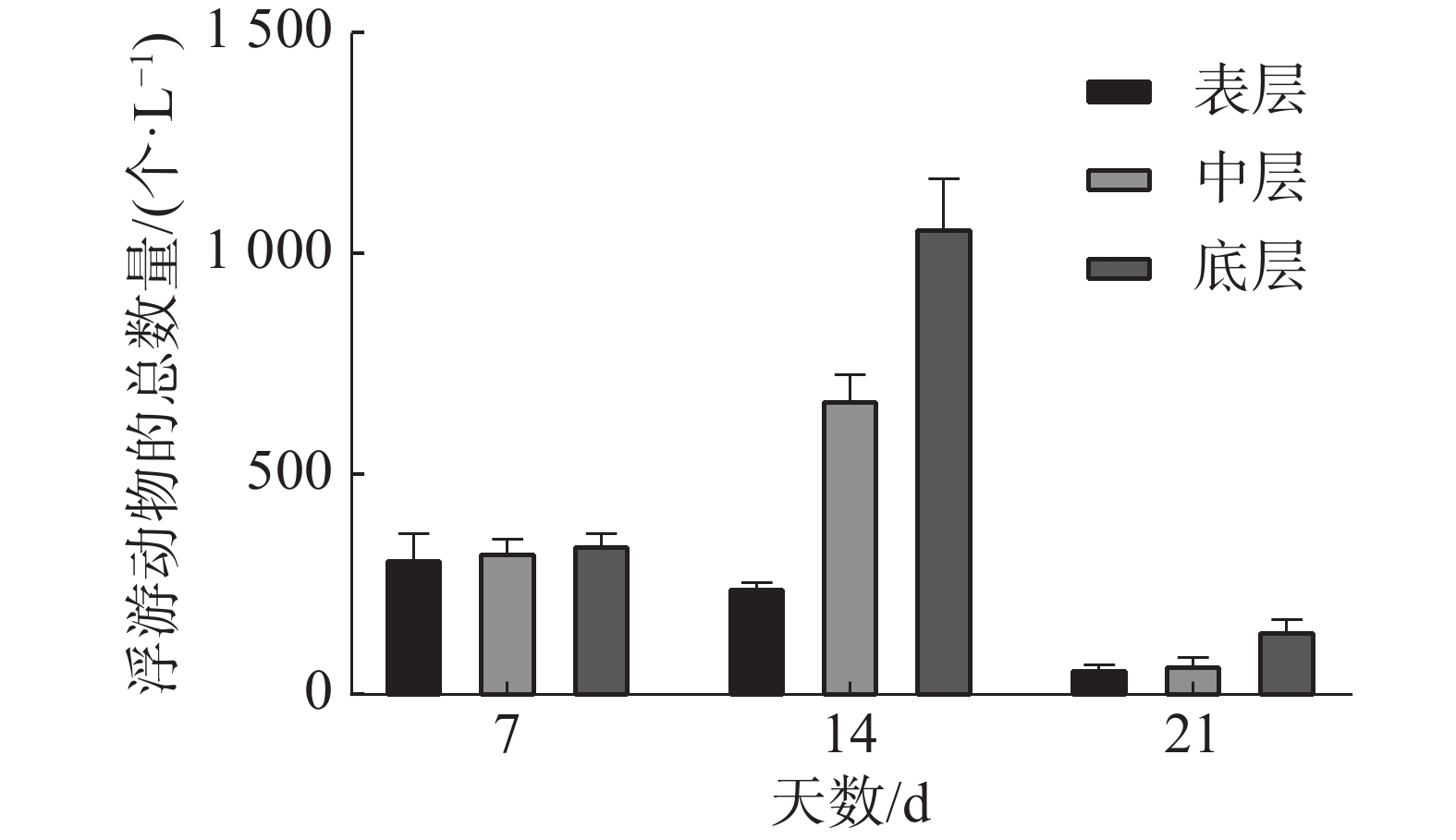-
对虾养殖业是我国水产养殖业的支柱性产业,自20世纪70年代末期到现在,我国对虾养殖业取得快速发展,养殖模式由传统的池塘纳潮粗放式养殖模式发展到虾与鱼、贝、蟹类生态混养模式[1-2],再到海水淡化养殖模式[3],卤水蜕淡水养殖模式[2],以及现在的高位池和地膜池精养模式[4-6]。 高位池精养模式摆脱了传统养殖模式受潮水及海区水质的影响,而且养殖源水经过沙滤、沉淀和含氯消毒剂消毒等多道程序处理以及良好的排污系统,从而减少病害发生,但存在虾池生物种类少等特点[7]。目前,高位池进水有3种方式:1)不经过滤等处理措施直接用动力抽取外海水;2)海水经在海边地下沙滤井沙滤后再抽到进水主渠;3)抽取源水进入蓄水沉淀池经含氯消毒剂等消毒药物处理后再抽取至虾池使用[8]。
浮游动物包括原生生物、轮虫、枝角类和桡足类,是重要的生态功能群[9],既可作为许多经济鱼虾类的优质天然饵料,同时又可作为消费者调控浮游微藻和微生物群落结构。浮游动物的种类组成、数量的分布和变动与池塘水质和系统内的物流、能流密切相关,它直接或间接影响到对虾的生长和系统的生产性能。浮游生物,在海洋生态系的物质循环和能量流动中有重要作用。浮游植物是虾池水体浮游生物的主体,对维持虾池生态系统的稳定起关键作用,浮游植物种类组成及优势种群种类和数量决定虾池环境稳定性。浮游动物作为虾池养殖水体生态环境的重要组成部分,可加速水体生态系统的物质循环,净化养殖环境[10-12]。近年来,随着养殖密度的增加和养殖产量的提高,养殖尾水的无序排放,导致海水富营养化越来越严重,蓝藻和甲藻等有毒有害藻类占比越来越大,除了病毒性疾病危害之外,还有未名病因的病害如肝胰腺坏死症、白便综合症等,很多跟藻毒素和弧菌等密切相关,采用处理水模式,可以切断病毒性病原等烈性病原的部分水平传播途径,有利于病害的防控,但是无法完全去除溶解性营养物质,无法控制有毒有害藻类和弧菌病的暴发,因此,本试验针对高位池2种进水方式及处理水养殖过程中浮游生物种类和数量的时空变化进行分析,旨在为对虾处理水养殖池塘浮游生物定向调控提供数据支撑,为对虾病害防控和可持续发展提供依据。
-
取样地点为海南莺歌海洋生物技术有限公司板桥养殖基地,取样时间为2021年4月3日—6月28日。试验池塘为水泥护坡、底部铺膜铺沙高位池,沙层厚度为0.3~0.5 m,单塘面积为0.4~0.5 hm2,池深2.3 m,水深1.8 m,单塘配备功率为0.75 kw台水车式增氧机8台。放养品种为凡纳滨对虾(Litopenaeus vannamei),放养密度为150万尾·hm−2。
-
试验地点为海南莺歌海洋生物技术有限公司板桥养殖基地的外海,近岸处的微表层水体,每隔50 m取1点,共取3点。间隔5日采1次水样,共采3次。
-
取样地点和取样时间同1.1.1。沙滤井建在高潮线附近,深度为6~10 m,井底低于最低低潮线约1~2 m,沙滤井内径6 m,井壁底部留有进水孔,外连内径为15~20 cm的PVC管6~8根,管上有直径为1~2 cm的孔,外包20目筛绢网,防止沙堵塞管道。采集沙滤井内表层、入渠处和入塘处3点的水样。间隔5日采1次水样,连续采3次。
-
从外海经过沙滤,抽水于蓄水池中,经沉淀后,用30 g·m−3的次氯酸纳处理消毒2 d后。取蓄水池东、西和北3面的水体。间隔5日采1次水样,共采3次。
-
采用0.074 mm浮游生物网采集浮游生物[13]。
-
用浮游生物网,绕∞字形路线,收集时间约1 min,将所得浮游生物收集于小塑料瓶内。
-
用采水器取水样1 L,加入10 mL鲁格氏液(Logul’s solution)固定。沉淀48 h后,吸取上层清液,将定量样品摇匀,取0.1 mL样品置于浮游植物计数框内,在显微镜下计数。根据以下公式计算出1 000 mL水样中所含浮游植物的个数:
式中:N 为每升原水样中浮游植物数量(个·L−1);A为计数框面积(mm2);Ac为计数面积(mm2);Vs为1 L原水样沉淀浓缩后的体积(mL);Va为计数框的体积(mL);n 为计数所得浮游植物的数目。
-
取10 L水样,用浮游生物网过滤,浓缩至15~30 mL(由生物多少决定),加4~7滴鲁格氏液(Logul’s solution)固定。沉淀24 h后,吸去上层清液,摇匀后取1 mL用浮游动物计数框计数。
-
在206#(凡纳滨对虾养殖后期139 d)西、南和北边各取一点水样,每天2次,分别于12:00时和24:00时各取1次。
-
在103#(凡纳滨对虾养殖前期5 d),202#(养殖102 d),204#(养殖140 d)中于每个塘的北面取表层、中层和底层的水样。表层为离水面5~10 cm;底层为离底部5~10 cm;中层为池水中部深度位置。
-
在103#,202#,204#的每个塘边缘,中央排污,边缘与中央排污的中点处各取表层水样。
-
结果以平均值±标准差( mean±sd) 表示,应用 SPSS 26.0 和 Excel 2019 软件对试验数据进行统计分析,对数据运用单因素方差分析( ANOVA) ,P<0.05 为有显著性差异。
-
从表1可知,外海水的浮游生物种类较多,共9门27属33种,浮游动物的优势种类有泡抱球虫(Globigerina bulloides)、卵细胞、浮游植物的优势种类有菱形藻(Nitzschia sp.)、胶鞘藻(Glue whiplash algae);处理水的浮游生物种类次之,共5门15属17种,浮游动物的优势种类有有孔虫(Textularia),浮游植物的优势种类有菱形藻、角毛藻(Chaetoceras sp.);沙滤水浮游生物种类相比最少,共5门15属16种,浮游动物优势种类有桡足类无节幼体(Copepoda larva)、卵细胞,浮游植物优势种类有菱形藻、裸甲藻[14-15]。
种类 外海水 处理水 沙滤水 第1次
取样第2次
取样第3次
取样第1次
取样第2次
取样第3次
取样第1次
取样第2次
取样第3次
取样中华哲水蚤
Calanus sinicus+ + + + + + 有孔虫
Textularia+ ++ ++ ++ 游仆虫
Eaploles+ 藤壶幼体
Cypris larva+ + + + + 卵细胞
Eggs++ ++ + + + + ++ 菱形藻
Nitzschia sp.+ + ++ ++ ++ + + 介形虫
Stracoda+ 急游虫
Strombidium viride stein+ + 席藻
phormidium+ + 绿海球藻
Halosphaera viridis+ + 泡抱球虫
Globigerina bulloides+ + ++ 菱形海线藻
Thalassionema nitzschioides+ + + 伊格抱球虫
Globigerina eggeri+ + 曲舟藻
Pleurosigma+ + + 羽纹藻
Pinnularia+ 圆筛藻
Coscinodiscus+ 美丽盒形藻
Bidd pulchella+ 似铃虫
Globigerinoides+ + 新月菱形藻
Nitzschia closlerium栅藻
Scenedesmus+ 活动盒形藻
Biddullphia mobiliensis+ + 念珠直链藻
Melosira moniliformis+ + + 桡足类无节幼体
Copepoda larve+ + + + 微囊藻
Microcystis+ + 角毛藻
Chaetoceras+ + ++ + 布氏双尾藻
Ditylum brightwellii+ + 太阳双尾藻
Ditylum sol+ 圆筛藻
Coscinodiscus sp.+ + 裸甲藻
Cymnodinium+ ++ 胶鞘藻
Phormidium++ ++ + + 穹杆藻
Achnanthes sp.+ 骨条藻
Skeletonema sp.+ 长菱形藻
Nitzschia longissima+ + 筒螅幼虫
Tubularia+ 颤藻
Oscillatoria+ + 平裂藻
Merismopedia+ 桥穹藻
Cymbella+ 扁藻
Platymonas+ 小球藻
Chlorella+ + + 笔尖根管藻
Rhizosolenia styliformis线虫
Nemathelminthes+ 叉边金藻
Dicrateria+ + + + 注:“+”代表该种类存在,“++”代表优势种类,下同。 -
从表2可知,处理水的浮游动物密度最大,3次采样的平均值为(131.57±78.16)个·L−1,主要以有孔虫(Textularia)、砂壳虫(Difflugia)为主,分别占浮游动物总数量的18 %~40 %和57 %。处理水的浮游动物数量显著高于外海水和沙滤水浮游动物数量(P<0.05)。外海水的浮游动物密度次之,平均值为(26.45±14.30)个·L−1,主要以卵细胞、泡抱球虫为主,分别占浮游动物总数量的31 %~47 %和26 %。沙滤水的浮游动物密度最小,平均值为(6.31±1.45)个·L−1 ,主要以桡足类无节幼体、卵细胞为主,分别占浮游动物总数量的57 %~81 %和38 % 。外海水和沙滤水的浮游动物数量的总密度两组差异不明显(P>0.05)。
种类外海水 处理水 沙滤水 占比
/%密度/
(个·L−1)占比
/%密度/
(个·L−1)占比
/%密度/
(个·L−1)占比
/%密度/
(个·L−1)占比
/%密度/
(个·L−1)占比
/%密度/
(个·L−1)占比
/%密度/
(个·L−1)占比
/%密度/
(个·L−1)占比
/%密度/
(个·L−1)桡足类无节幼体
Copepoda larve1 0.40 14 2.03 6 1.35 18 13.4 10 22.1 2 1.97 57 2.86 7 0.42 中华哲水蚤
Calanus sinicus9 3.80 21 3.05 7 1.58 7 5.20 17 59.6 9 8.89 10 0.61 筒螅幼虫
Tubularia2 0.80 3 0.44 6 1.36 14 0.70 3 0.24 似铃虫
Globigerinoides13 5.50 8 1.80 泡抱球虫
Globigerina bulloides13 5.50 7 1.02 26 5.85 伊格抱球虫
Globigerina eggeri3 1.30 11 2.48 卵细胞
Eggs47 20 31 4.50 14 3.15 10 22.1 7 6.91 7 0.35 81 6.37 38 2.30 藤壶幼体
Cypris larva1 0.15 33 25.6 9 19.8 2 1.97 3 0.24 砂壳虫
Difflugia57 56.2 14 0.70 有孔虫
Textularia6 2.50 14 2.03 8 1.80 40 29.6 39 86.1 18 17.8 壶状臂尾轮虫
Brachionus urceus3 0.24 线虫
Nemathelminthes6 0.48 24 1.45 光亮拟铃虫
Tintinnopsis6 1.35 急游虫
Strombidium viride stein7 0.42 游仆虫Eaploles 3 0.18 其他 6 2.50 9 1.31 8 1.80 2 1.40 5 11.1 5 4.94 8 0.40 4 0.31 11 0.67 总密度/((个·L−1)) 42.30 14.53 22.52 75.20 220.80 98.72 5.01 7.88 6.05 平均值±标准/((个·L−1)) 26.45±14.30b 131.57±78.16a 6.31±1.45b 注:同一行上标不同字母表示差异显著(P<0.05),下同。 从表3可知,处理水浮游植物个体数量变化很快,第1次采样密度为1.4×105个·L−1,第2次采样密度为2.6×105个·L−1,第3次采样密度上升为3.6×106个·L−1, 3次采样的平均密度为1.3×106个·L−1,三者之中最高,其优势种类为菱形藻和角毛藻,分别占浮游植物总数量的29 %~37 %和93 % 。外海水浮游植物的平均密度为(3.03±1.62)×105个· L−1,低于处理水,高于沙滤水,其优势种类为胶鞘藻和菱形藻,分别占浮游植物总数量的60 %~70 %和29 % 。沙滤水浮游植物的平均密度为(2.63±1.24)×105个·L−1,其优势种类为菱形藻和裸甲藻,分别占浮游植物总数量的35 %、47 %和45 % 。处理水的浮游植物数量显著高于外海水和沙滤水浮游植物数量(P<0.05),外海水和沙滤水的浮游植物数量两组差异不明显(P>0.05)。
种类 外海水 处理水 沙滤水 占比/
%密度/
(×105
个·L−1)占比/
%密度
(×105
个·L−1)/占比/
%密度/
(×105
个·L−1)占比/
%密度/
(×105
个·L−1)占比/
%密度/
(×105
个·L−1)占比/
%密度/
(×105
个·L−1)占比/
%密度
(×105
个·L−1)/占比/
%密度
(×105
个·L−1)/占比/
%密度/
(×105
个·L−1)菱形藻Nitzschia sp. 15 0.30 11 0.55 29 0.63 37 0.51 29 0.75 2 0.73 47 0.59 35 1.20 2 0.07 骨条藻Skeletonema sp. 15 0.33 6 0.08 2 0.07 曲舟藻Pleurosigma 8 0.16 11 0.15 小环藻Cyclotella 8 0.16 11 0.15 小球藻Chlorella 22 0.30 17 0.21 卵囊藻Oocystis 15 0.21 4 0.10 30 0.38 绿海球藻Halosphaera viridis 4 0.08 5 0.25 3 0.07 21 0.70 活动盒形藻Biddullphia mobiliensis 3 0.06 胶鞘藻Phormidium 60 1.20 70 3.40 23 0.49 19 0.49 30 1.00 微囊藻Microcystis 3 0.15 19 0.49 裸甲藻Cymnodinium 3 0.15 6 0.13 25 0.64 3 1.11 45 1.50 平裂藻Merismopedia 4 0.20 念珠直链藻Melosira moniliformis 2 0.10 30 1.00 26 0.87 菱形海线藻Thalassionema nitzschioides 18 0.39 1 0.37 长菱形藻Nitzschia longissima 3 0.07 角毛藻Skeletonema sp. 93 34.0 其他 2 0.04 2 0.10 3 0.07 4 0.06 4 0.10 1 0.37 5 0.20 4 0.13 总数量/(×105个·L−1) 2.0 4.90 2.20 1.40 2.60 36.0 1.20 3.40 3.30 平均值±标准差/(×105个·L−1) 3.03±1.62b 13.33±19.64a 2.63±1.24b -
从表4可知,浮游动物的总数量夜晚取样平均值为(408±345)个·L−1;高于白昼取样平均值为(169±97)个·L−1,两组差异不显著(P>0.05)。
水样 种类数/种 密度/(×102个·L−1) 昼 夜 昼 夜 第1次取样 13 14 1.43 7.91 第2次取样 12 13 2.77 3.14 第3次取样 12 11 0.87 1.20 从表5可知,种类基本没差异,昼夜的优势种类相同,浮游植物总数量白昼取样平均值为(3.00±1.67)×107个·L−1;高于夜晚,取样平均值为(2.71±1.51)×107个·L−1,两组差异不显著(P>0.05)。
水样 种类数 总数量(×107个·L−1) 优势种 昼 夜 昼 夜 第1次取样 7 7 3.88 3.71 胶鞘藻Phormidium 第2次取样 9 8 4.05 3.45 胶鞘藻Phormidium 第3次取样 8 10 1.08 0.97 裸藻
Euglena sp. -
从表6可知,在垂直方向上各个不同时期的塘的浮游生物组成差异小,除了103#底部水样生物总种类数略高于表层中层外,其他塘的生物种类在垂直方向上总数相近。在垂直方向上浮游动物总数量的变化是从表层−中层−底层呈增多趋势,浮游植物总数量分布呈表层高于中层和底层的现象。
种类 第1次取样 第2次取样 第3次取样 虾塘编号 虾塘编号 虾塘编号 103# 202# 204# 103# 202# 204# 103# 202# 204# 表 中 底 表 中 底 表 中 底 表 中 底 表 中 底 表 中 底 表 中 底 表 中 底 表 中 底 砂壳虫
Difflugia+ + + + + + + + + + + + + + + 卵细胞
Eggs+ + + + + + + + + + + + + + + + + + + + + + + + + + 急游虫
Strombidium viride stein+ + + + + + + + + + + + + + + 游仆虫
Eaploles+ + + + + + + 桡足类无节幼体
Copepoda larve+ + + + + + + + 中华哲水蚤
Calanus sinicus+ + + + + + + + + + + + + + + + 厦门网纹虫
Favella amoyensis+ 筒螅幼虫
Tubularia+ + + + + + + + + + + + + 吸壳虫
Acineta+ + 钟虫
Vorticella+ + + + + + 壶状臂尾轮虫 + + + + + + + + + + 磷虾幼体
Copepodite larva+ + + 线虫
Nemathelminthes+ 巴拿马网纹虫
Favella panamensis+ 藤壶幼体
Cypris larva+ + 钟状网纹虫
Favella campanula+ + + + 有孔虫
Textularia+ 似铃虫
Globigerinoides+ + 裸甲藻
Cymnodinium+ + + + + + + + + + + + + + + + + + + + + + + + + + 薄甲藻
Glenodinium+ + + + + + + + + 裸藻
Euglena sp.+ + + + + + + + + + + + + + + + + + 胶鞘藻
Phormidium+ + + + + + + + + + + + + + + + + + + + + + + + + 菱形藻
Nitzschia sp.+ + + + + + + + + + + + + + + + + + + + + + + + + 长菱形藻
Nitzschia longissima+ + + + + + + + + + + + + + + + 扁藻
Playmonas+ + + + + + + + + 平裂藻
Merismopedia+ + + + + + 波纹藻
Cymatopleura+ + + + + + + + + + 桥穹藻
Cymbella+ + + + + + + + 曲舟藻
Pleurosigma+ + + 羽纹硅藻
Pinnularia+ 舟形藻
Navicula Bory+ + + + + + + + + + + 念珠直链藻
Melosira moniliformis+ 布纹藻
Gyrosigma+ 绿海球藻
Halosphaera viridis+ + + + + + + + 笔尖根管藻
Rhizosolenia styliformis+ + + + + + + + + 总浮游生物种类数 8 13 16 15 14 14 10 9 9 8 9 10 14 11 13 9 11 10 13 13 18 12 9 10 16 12 13 -
在垂直方向上,不同时期塘的浮游动物数量的变化从表层−中层−底层呈增多的趋势(图1、 2、 3)。
从表7可知,在垂直方向上,浮游植物数量分布呈表层高于中层和底层现象,各池中的优势种类在垂直方向上基本相同。103#、202#和204#表层浮游植物的总数量平均值分别为(2.19±1.46)×106个·L−1、(24.31±13.32)×106个·L−1和(25.27±9.61)×106个·L−1;103#表层浮游植物的总数量显著低于202#和204#表层浮游植物的总数量(P<0.05),202#和204#表层浮游植物的总数量两组差异不明显(P>0.05);103#、202#和204#中层浮游植物的总数量平均值分别为(1.71±0.97)×106个·L−1、(16.91±10.37)×106个·L−1和(20.83±3.51)×106个·L−1。103#中层浮游植物的总数量显著低于202#和204#中层浮游植物的总数量(P<0.05),202#和204#表层浮游植物的总数量两组差异不明显(P>0.05);103#、202#和204#底层浮游植物的总数量平均值分别为(1.34±1.03)×106个·L−1、(20.52±12.67)×106个·L−1和(14.50±2.36)×106个·L−1,数据组间差距均不显著(P>0.05)。
取样点 第1次取样 第2次取样 第3次取样 数量/
(×106个·L−1)优势种 占比/% 数量/
(×106个·L−1)优势种 占比/% 数量/
(×106个·L−1)优势种 占比/% 103# 表 0.98 菱形藻
Nitzschia sp.32.49 3.81 菱形藻
Nitzschia sp.41.99 1.80 裸藻
Euglena sp.66.62 中 0.59 菱形藻
Nitzschia sp.30.88 2.25 裸藻
Euglena sp.43.91 2.29 裸藻
Euglena sp.62.71 底 0.74 菱形藻
Nitzschia sp.41.46 2.53 裸藻
Euglena sp.48.22 0.75 菱形藻
Nitzschia sp.49.00 202# 表 9.14 裸藻
Euglena sp.38.94 34.10 裸藻
Euglena sp.73.03 29.70 裸藻
Euglena sp.77.78 中 7.14 胶鞘藻
Phormidium45.02 27.80 裸藻
Euglena sp.64.97 15.80 裸藻
Euglena sp.66.46 底 6.26 胶鞘藻
Phormidium38.82 30.50 裸藻
Euglena sp.71.33 24.80 裸藻
Euglena sp.75.40 204# 表 36.3 胶鞘藻
Phormidium82.46 18.70 裸藻
Euglena sp.54.55 20.80 裸藻
Euglena sp.40.63 中 21.1 胶鞘藻
Phormidium75.21 17.20 裸藻
Euglena sp.38.20 24.20 裸藻
Euglena sp.44.63 底 17.1 胶鞘藻
Phormidium46.73 12.50 裸藻
Euglena sp.31.68 13.90 裸藻
Euglena sp.33.96 -
从表8可知,103#、202#和204#塘边浮游动物的总数量平均值分别为(822.33±1 102.90)个·L−1、(1 532.33±900.02)个·L−1和(912.33±764.55)个·L−1;103#、202#和204#中点浮游动物的总数量平均值分别为(625.00±546.96)个·L−1、(2786.00±3230.75)个·L−1和(808.00±677.44)个·L−1;103#、202#和204#中央浮游动物的总数量平均值分别为(782.00±781.93)个·L−1、(4 444.67±5 855.80)个·L−1和(1 348.33±1 032.53)个·L−1;浮游动物种类在各个不同时期的塘中和组成和总量在水平方向上变化规律不明显,无显著性差异(P>0.05),种类数相差不大,其优势种类几乎一样。
取样点 第1次取样 第2次取样 第3次取样 种类
数/种数量/
(个·L−1)优势种 种类
数/种数量/
(个·L−1)优势种 种类
数/种数量/
(个·L−1)优势种 103# 塘边 7 20 卵细胞Eggs 7 2080 游仆虫
Eaploles7 367 砂壳虫
Difflugia中点 5 128 卵细胞Eggs 5 1211 砂壳虫
Difflugia7 536 砂壳虫
Difflugia中央 5 23 卵细胞Eggs 5 1585 游仆虫
Eaploles6 738 砂壳虫
Difflugia202# 塘边 8 1206 砂壳虫
Difflugia9 841 游仆虫
Eaploles7 2550 游仆虫
Eaploles中点 8 625 砂壳虫
Difflugia7 1233 游仆虫
Eaploles5 6500 游仆虫
Eaploles中央 7 1321 砂壳虫
Difflugia9 813 游仆虫
Eaploles6 11200 游仆虫
Eaploles204# 塘边 10 556 急游虫
Strombidium
viride stein9 391 游仆虫
Eaploles10 1790 砂壳虫
Difflugia中点 9 52 卵细胞Eggs 9 1012 游仆虫
Eaploles9 1360 砂壳虫
Difflugia中央 14 360 急游虫
Strombidium viride stein8 1265 砂壳虫
Difflugia10 2420 砂壳虫
Difflugia -
如表9所示:103#、202#和204#塘边浮游植物的总数量平均值分别为(1.37±0.32)×106个·L−1、(33.93±3.40)×106个·L−1和(27.56±8.73)×106个·L−1,103#塘边浮游植物的总数量显著低于202#和204#塘边浮游植物的总数量(P<0.05),202#和204#塘边浮游植物的总数量两组差异不明显(P>0.05)。
取样点 第1次取样 第2次取样 第3次取样 种类
数/种数量/
(×106个·L−1)优势种 种类
数/种数量/
(×106个·L−1)优势种 种类
数/种数量/
(×106个·L−1)优势种 103# 塘边 9 1.63 裸甲藻
Cymnodinium8 1.01 长菱形藻
Nitzschia longissima9 1.47 裸藻
Euglena sp.中点 9 1.79 裸甲藻
Cymnodinium8 1.13 长菱形藻
Nitzschia longissima8 1.59 裸藻
Euglena sp.中央 10 1.35 菱形藻
Nitzschia sp.7 1.59 长菱形藻
Nitzschia longissima8 1.21 裸藻
Euglena sp.202# 塘边 9 32.60 裸藻
Euglena sp.7 31.40 裸藻
Euglena sp.8 37.80 胶鞘藻
Phormidium中点 9 24.28 裸藻
Euglena sp.8 23.23 裸藻
Euglena sp.8 31.21 胶鞘藻
Phormidium中央 9 32.30 裸藻
Euglena sp.7 25.90 裸藻
Euglena sp.9 35.10 胶鞘藻
Phormidium204# 塘边 8 24.85 裸藻
Euglena sp.9 20.51 裸藻
Euglena sp.10 37.32 裸藻
Euglena sp.中点 6 21.90 裸藻
Euglena sp.11 30.40 裸藻
Euglena sp.7 35.20 裸藻
Euglena sp.中央 5 16.36 裸藻
Euglena sp.11 20.68 裸藻
Euglena sp.9 34.90 裸藻
Euglena sp.103#、202#和204#中点浮游植物的总数量平均值分别为(1.50±0.34×106个·L−1、(26.24±4.34)×106个·L−1和(29.17±6.74)×106个·L−1,103#中点浮游植物的总数量显著低于202#和204#中点浮游植物的总数量(P<0.05),202#和204#中点浮游植物的总数量两组差异不明显(P>0.05)。
103#、202#和204#中央浮游植物的总数量平均值分别为(1.38±0.19×106个·L−1、(31.10±4.72)×106个·L−1和(23.98±9.70)×106个·L−1,103#中央浮游植物的总数量显著低于202#和204#中央浮游植物的总数量(P<0.05),202#和204#中央浮游植物的总数量两组差异不明显(P>0.05)。
浮游植物种类组成在各个不同时期虾塘中无明显的水平分布差异,水平方向上的3个取样点的优势种几乎相同。浮游植物总量在水平方向上分布有明显差异。
-
本研究结果表明,外海水所含浮游生物的种类数量最多,处理水次之,沙滤水最少。何建国等[7]的研究结果表明:外海水存在一些病毒的宿主生物,如WSSV自然寄主猛水蚤,剑水蚤,部分哲水蚤目种类和介形类动物,非养殖虾、蟹等。1979年,研究人员通过电镜检测,第1次证明了病毒在海水中的大量存在[16],同年,人们也第1次分离出海洋浮游植物病毒[17-18](一种可以感染微型鞭毛藻Micromonas Pusilla的病毒)。目前,已经观察到病毒粒子在真核藻类细胞中普遍存在[11]。不经处理直接引入外海水的养殖模式已逐渐被淘汰。从病毒防治的角度看,处理水的养殖效果最好,沙滤水虽然在一定程度上阻断了WSSV等病毒的自然寄主,但仍可能含有携带游离病毒或病毒的宿主生物。本实验用30 g·m−3的次氯酸钠基本已经杀灭水体中所有浮游生物,但处理水中的浮游生物种类仍比过滤水多,如有孔虫(3次取样平均为44.5个·L−1),卵细胞(3次取样平均为9.7个·L−1),笔者认为可能是因为次氯酸钠对浮游动物的卵细胞杀灭不彻底[8]。
高位精养虾池中浮游动物总量表现出夜晚比白昼多的现象与郑重等[13]的研究结果“夜晚上升,白天下降”一致。浮游植物总量则表现出白昼比夜晚多的现象,可能是浮游动物的背光性和浮游植物的趋光性造成。研究表明,上述现象与风力、水流、食料、光度、温度和浮游生物的生理等有关[18-21]。浮游生物在垂直方向上变化的主要原因是引起昼夜变化因素作用的结果[22-24]。浮游生物在水平方向上种类和数量都无规律差异,与高位池的结构有关,高位池是一个小型生态系统,增氧机搅动水体,池塘中表层水浮游生物水平分布趋于均匀[25-27]。
Temporal and spatial variation of plankton in high level intensive cultural shrimp pond with treated water
doi: 10.15886/j.cnki.rdswxb.2022.05.002
- Received Date: 2022-03-01
- Rev Recd Date: 2022-03-29
- Available Online: 2022-07-04
- Publish Date: 2022-09-21
-
Key words:
- treated water /
- Litopenaeus vannamei /
- plankton /
- change
Abstract: A combination of sand filtration, storage precipitation and chlorine-containing disinfectant was used to treat the aquaculture water for intensive culture of Litopenaeus vannamei in high level ponds. The differences of plankton in the offshore seawater, sand filtrated water and treated water were compared, and the temporal and spatial changes of plankton in the aquaculture water were analyzed. The results showed that there were many species of plankton in the offshore water, including 33 species belonging to 27 genera and 9 phyla. There were 17 species of plankton in the treated water, belonging to 15 genera and 5 phyla, second to those in the offshore water. There were 16 species of plankton in the sand filtrated water, belonging to 5 phyla 15 genera. The number of zooplankton was significantly higher in the treated water than in the offshore water and the sand filtrated water (P < 0.05). The zooplankton density in the offshore seawater was the second highest, with an average of (26.45±14.30) ·L−1. The zooplankton density in the sand filtrated water was the lowest, with an average of (6.31±1.45) ·L−1. The number of phytoplankton was significantly higher in the treated water than in the offshore seawater and the sand filtrated water (P < 0.05), but there was no significant difference between the two (P > 0.05). In the vertical direction, the change in total number of phytoplankton increased from the surface layer to the middle layer and then to the bottom layer, and the distribution of the total number of phytoplankton was higher in the surface layer than in middle layer and the bottom layer, but with no significant difference (P > 0.05). In the horizontal direction, there was significant difference in the distribution of the total number of phytoplankton in the horizontal direction (P < 0.05). These results might provide reference for the directional regulation of plankton in shrimp aquaculture ponds and shrimp disease control.
| Citation: | DAI Linxin, ZHOU Xiaolei, YANG Shu, HOU Danqing, SUN Chengbo. Temporal and spatial variation of plankton in high level intensive cultural shrimp pond with treated water[J]. Journal of Tropical Biology, 2022, 13(5): 429-439. doi: 10.15886/j.cnki.rdswxb.2022.05.002 |


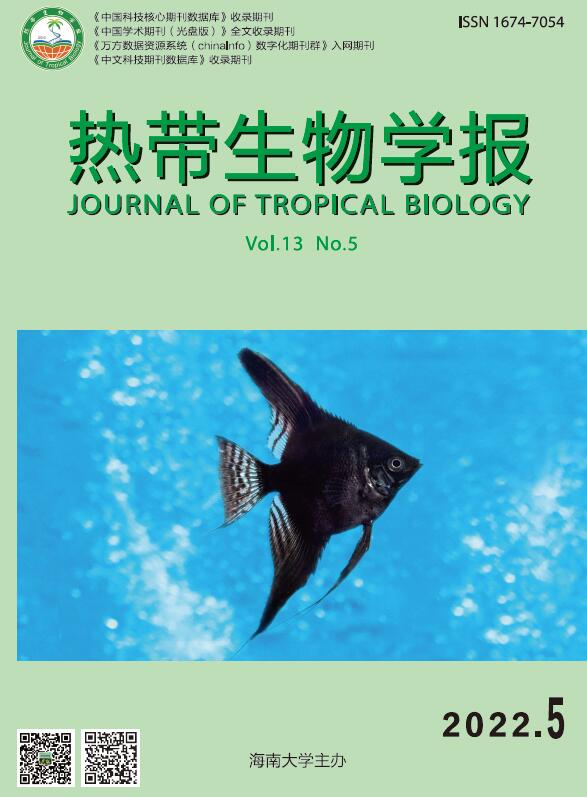


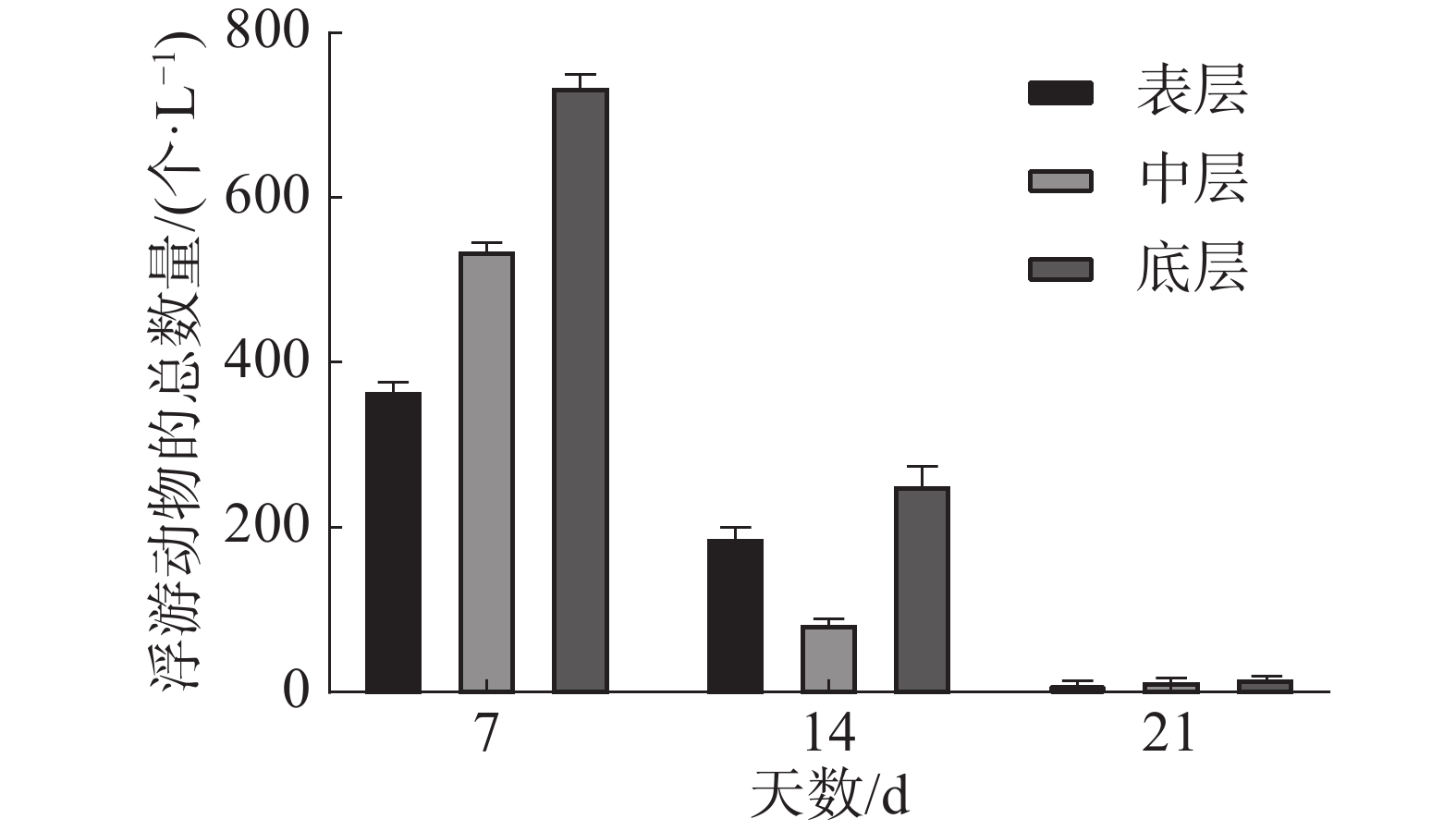

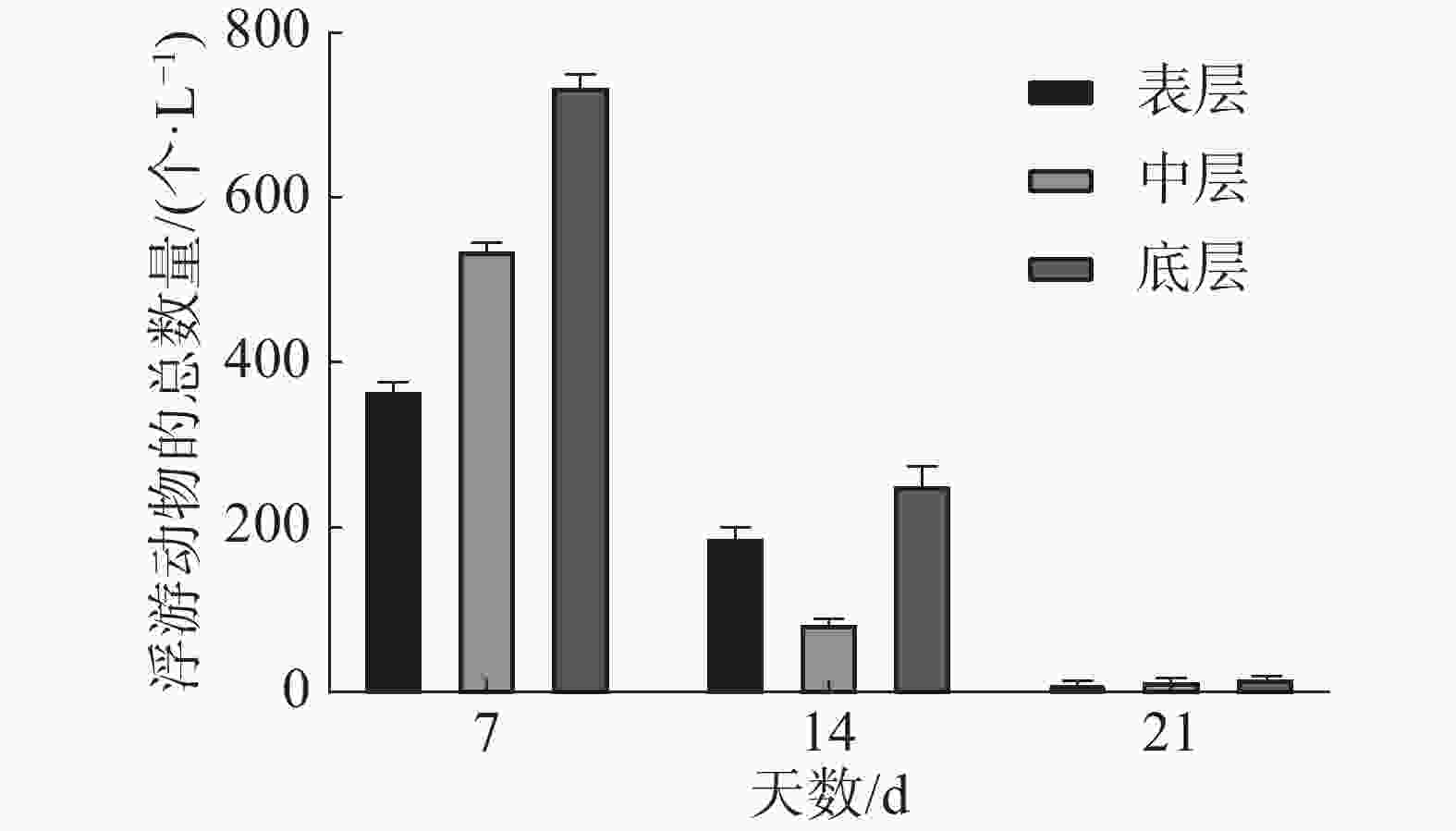
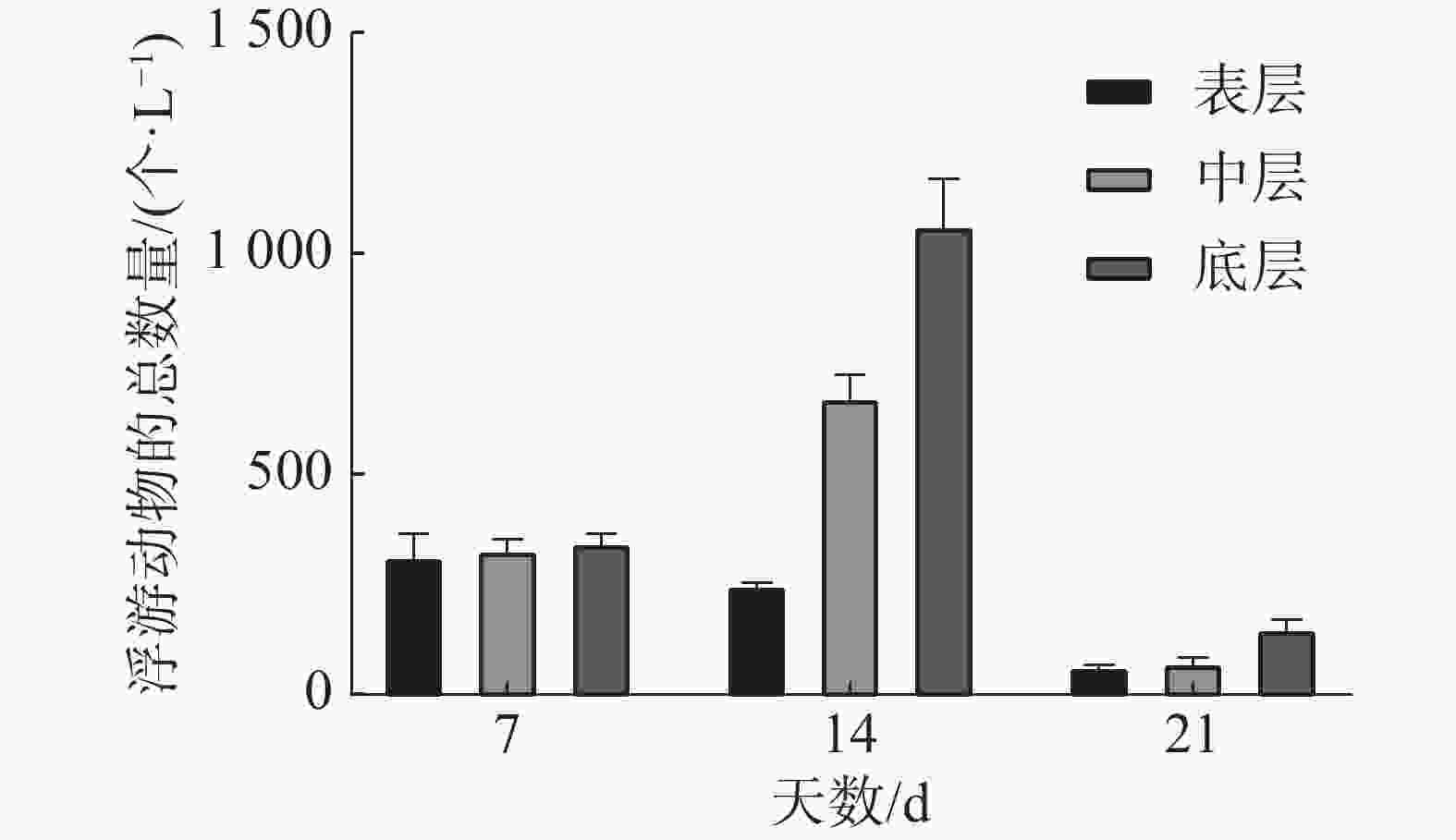
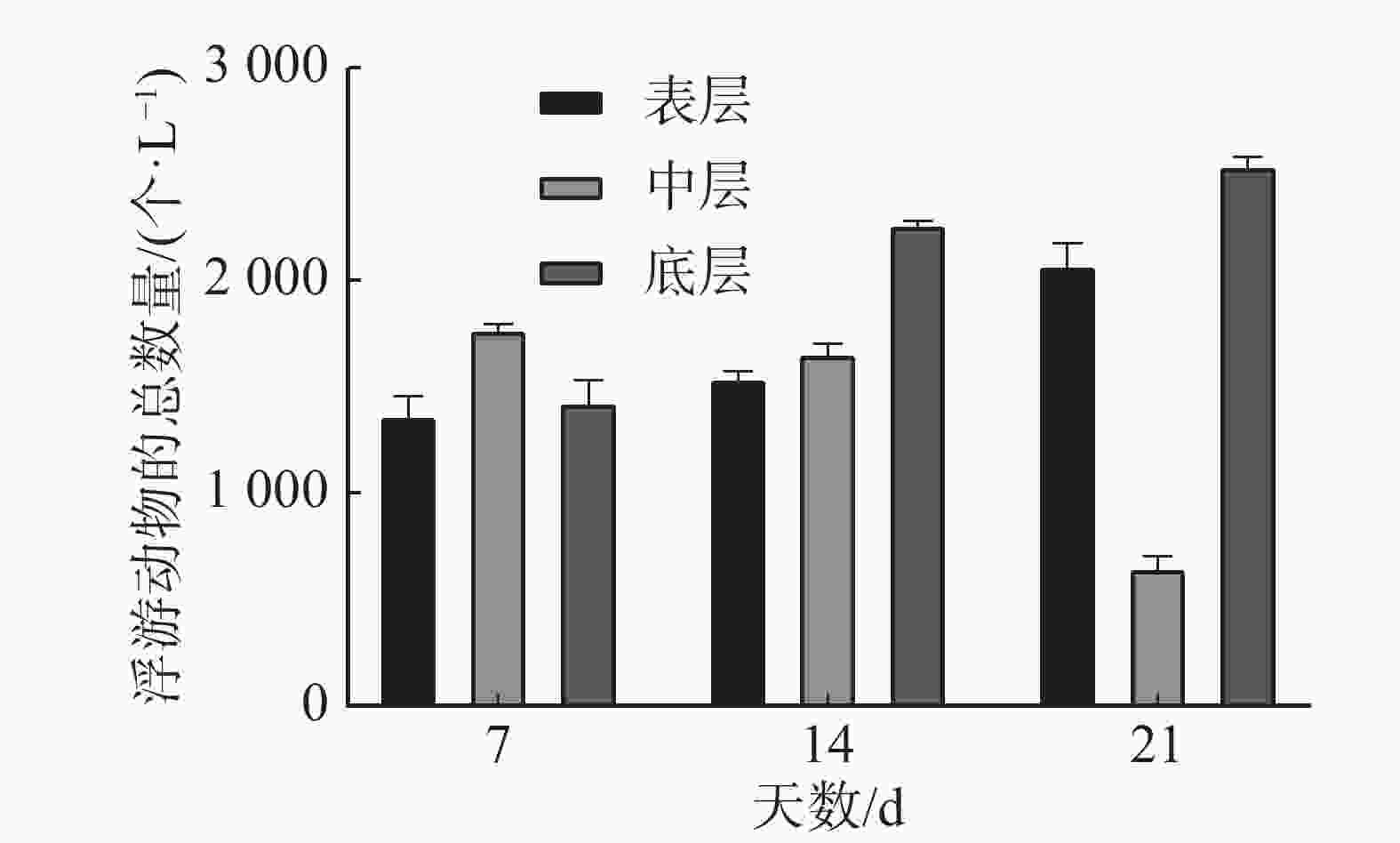
 DownLoad:
DownLoad:
